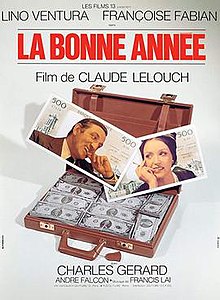| This article needs additional citations for verification. Please help improve this article by adding citations to reliable sources. Unsourced material may be challenged and removed. Find sources: "La bonne année" – news · newspapers · books · scholar · JSTOR (February 2024) (Learn how and when to remove this message) |
| La bonne année | |
|---|---|
 | |
| Directed by | Claude Lelouch |
| Screenplay by | Claude Lelouch and Pierre Uytterhoeven |
| Cinematography | Jean Collomb |
| Edited by | Georges Klotz |
| Music by | Francis Lai |
| Production companies | |
| Distributed by | Films 13 |
| Release date |
|
| Running time | 115 minutes |
| Country | France |
| Language | French |
La bonne année (also known in the United States as Happy New Year) is a 1973 film directed by Claude Lelouch. It tells the story of a gangster who organises a successful heist but is himself caught and jailed. Released early, he not only recoups his share of the takings but also regains his girlfriend. The film is edited to present a nonlinear narrative, with the beginning and ending of the film showing the present-day in black-and-white, and the center of the film showing a flashback of the events in color.
Plot
The gangster Simon and his faithful accomplice Charlot take a holiday in Cannes. Their plan is to rob the Van Cleef & Arpels jewellery shop on the seafront. Exhaustively, they watch and log the movements of the staff and the security routines. Disguised as a rich old man, Simon gets to know the manager by choosing items for an alleged sick sister. He also gets distracted by Françoise, the beautiful owner of the antiques shop next door. She is on her own and willing to enjoy dates.
On the night of the heist, Charlot manages to hide in the shop at closing time and at gunpoint gets the manager to fill an attaché case with all the jewels and cash. He then lets Simon in and heads off with the loot in a speedboat. As Simon ties and gags the manager, the place is surrounded by police because an alarm had been triggered. Françoise visits Simon in jail and promises she will wait for him.
After six years, as the police have not found Charlot or any of the loot, they think of a plan. They will get Simon released early and shadow him. He eludes his pursuers and finds Charlot, who gives him his share and drives him to the airport for a plane to Brazil. Waiting for his flight to be called, he rings Françoise. She tells him to come to her apartment immediately, which he does.
Cast
- Lino Ventura: Simon
- Françoise Fabian: Françoise
- Charles Gérard: Charlot
- André Falcon: bijoutier
- Lilo De La Passardière: Mme Félix
- Claude Mann: Claude
- Frédéric de Pasquale: Henri
- Gérard Sire: prison director/voix commentaire TV
- Silvano Tranquilli: italian lover
- Bettina Rheims: Nicole
- Georges Staquet: commissaire
- Harry Walter: 1st detective
- Elie Chouraqui: Michel Barbier (uncredited)
- Michel Bertay: taxi driver
- Michou (cabaret artist): himself
- Mireille Mathieu: herself
- André Barello
- Norman de la Chesnaye
- Pierre Edeline
- Pierre Cottier
- Joseph Rythmann
- Jacques Villedieu.
- Pierre Pontiche
Financing and production
Much of the film was financed by advertising, particularly for Van Cleef & Arpels.
Awards
- Best actor at the San Remo Film Festival for Lino Ventura and Françoise Fabian
- Prix Triomphe du Cinéma 1973
American remake
The film was remade as Happy New Year (1987), directed by John G. Avildsen and starring Peter Falk, Charles Durning and Tom Courtenay.
References
- "La bonne année". cinematheque.fr (in French). Retrieved 2024-02-06.
- Canby, Vincent (7 August 1987). "Film: 'Happy New Year'". The New York Times. Retrieved 6 February 2024.
External links
This article related to a French film of the 1970s is a stub. You can help Misplaced Pages by expanding it. |